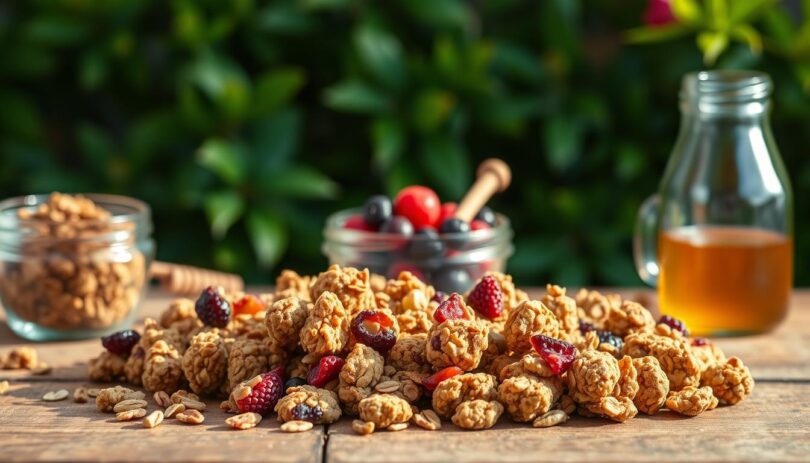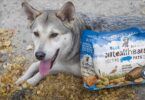Did you know 42% of pet owners unknowingly feed their dogs human foods containing toxic ingredients? While plain oats and honey-based granola might seem harmless, many store-bought varieties hide dangers for four-legged companions. This raises a critical question for snack-sharing pet parents: is this crunchy treat truly safe?
Granola’s safety hinges on its ingredients. Basic recipes without additives pose minimal risk in small amounts. However, chocolate, raisins, or artificial sweeteners like xylitol – common in commercial mixes – can trigger life-threatening reactions. Even “healthy” options may include macadamia nuts, which are toxic to pets.
This guide breaks down nutritional considerations and hidden hazards across both packaged and homemade varieties. You’ll discover practical portion guidelines and learn to identify red flags in ingredient lists. Upcoming sections will clarify how to balance occasional treats with your pup’s dietary needs while avoiding emergency vet visits.
Our analysis draws on veterinary research and pet nutrition studies to deliver trustworthy, actionable advice. Whether you’re considering sharing breakfast leftovers or exploring new snacks, we’ll help you make informed choices that prioritize your dog’s well-being.
Understanding Granola and Its Ingredients
Granola’s composition determines its suitability for canine consumption. While human-grade recipes often prioritize taste and texture, pet-safe versions require careful evaluation of every component.
Common Ingredients in Traditional Granola
Base mixtures typically combine rolled oats or puffed brown rice with binding agents like honey. These starchy foundations provide dietary fiber but lack complete nutrition for animals. Additions such as almonds or sunflower seeds introduce healthy fats, though some nuts pose serious health risks.
Dried fruits frequently appear in commercial blends. While cranberries or apples might seem harmless, others like raisins carry toxicity concerns. Sweeteners vary from natural maple syrup to artificial alternatives, requiring particular scrutiny.
Differences Between Store-Bought and Homemade Variations
Prepackaged options often contain preservatives and flavor enhancers absent in kitchen-made recipes. Homemade versions let owners eliminate problematic elements while boosting beneficial components like pumpkin seeds. This control reduces exposure to xylitol and chocolate chips – common hazards in mass-produced mixes.
Clear labeling proves essential when selecting commercial products. Look for whole-food components listed first, avoiding vague terms like “natural flavors.” Proportion matters too – even safe ingredients become problematic in excessive quantities.
Can dogs eat granola: Key Facts and Considerations
Pet owners often wonder how much of a human snack is safe for their companion. While plain oat-based mixes might seem harmless, even approved varieties require strict portion control. Veterinary nutritionists emphasize treats should never exceed 10% of daily caloric intake to maintain balanced nutrition.
Portion Guidelines Based on Dog Size
Small breeds under 20 pounds should receive no more than ½ teaspoon occasionally. Medium-sized pets (20-50 lbs) can handle up to 1 tablespoon weekly. Larger dogs may tolerate 2 tablespoons monthly, provided the mix contains only safe ingredients.
Always account for other treats given throughout the day. Overfeeding risks weight gain and nutrient deficiencies. Measure portions using kitchen scales or measuring spoons for accuracy.
When to Offer as an Occasional Treat
Use these crunchy bites sparingly during training sessions or as meal toppers. Avoid daily consumption – reserve them for special rewards. Ideal timing aligns with active periods when pets burn extra calories.
Watch for digestive issues like loose stools or vomiting, which signal intolerance. Rotate treats regularly to prevent dietary boredom. Always pair with fresh water to aid digestion.
Remember: even pet-safe versions work best as rare indulgences. Consult your vet to determine appropriate amounts for your pup’s specific needs and health status.
Toxic Ingredients to Avoid in Granola for Dogs
Many pet-friendly snacks hide dangerous components that require careful scrutiny. Four common additives in granola mixtures can trigger severe health crises, even in small doses. Veterinary studies show over 75% of toxicity cases stem from owners unknowingly feeding these substances.
Hazards of Raisins, Grapes, and Chocolate
Grapes and raisins rank among the most deceptive toxic ingredients. Consuming just 0.1 ounces per pound of body weight can cause kidney failure. Chocolate contains theobromine, which disrupts heart rhythms and nervous system functions.
Dark varieties pose higher risks than milk chocolate. Symptoms like vomiting or tremors may appear within hours. Immediate veterinary care becomes critical if exposure occurs.
The Risks of Xylitol and Macadamia Nuts
Xylitol, a sugar substitute in “sugar-free” products, triggers rapid insulin spikes. This artificial sweetener causes life-threatening hypoglycemia within 30 minutes. Macadamia nuts induce weakness and hyperthermia, with effects lasting 48 hours.
Other nuts like walnuts may harbor mold toxins. Always check ingredient lists for these harmful ingredients before sharing any human snacks. Manufacturers often use vague terms like “natural flavors” to mask xylitol.
Practical safety steps include scanning labels for ingredients like raisins or chocolate chips. Contact animal poison control if accidental ingestion occurs. Store granola securely to prevent curious paws from accessing toxic dogs’ worst enemies.
Health Implications of Granola for Dogs
Balancing nutritional benefits with potential risks requires understanding how snacks affect pets internally. While some ingredients offer value, their combined impact on metabolism demands careful evaluation.
Impact on Blood Sugar and Weight
High sugar content in commercial mixes can destabilize energy levels. A single serving may contain 8-12 grams of sweeteners – equivalent to 20% of a small dog’s daily calorie needs. This surge often leads to hyperactivity followed by crashes, stressing the pancreas.
Fiber from oats and brown rice aids digestion but complicates absorption. While soluble fiber helps regulate blood sugar, excessive amounts may cause bloating. The combination of slow-digesting fiber and quick-release sugars creates conflicting metabolic signals.
Weight management becomes challenging with calorie-dense snacks. Studies show pets consuming sugary treats twice weekly gain 17% more weight annually than those on controlled diets. Portion control proves critical, as even “healthy” content quickly adds excess energy.
Veterinarians recommend tracking treat calories alongside regular meals. Watch for issues like lethargy or increased thirst, which signal blood sugar imbalances. Rotate fiber-rich snacks with protein-based options to maintain nutritional diversity without overloading systems.
Ultimately, occasional small portions of simplified recipes might fit some diets. Always prioritize vet-approved guidelines over temporary cravings. Regular health checkups help catch subtle changes before they escalate.
Alternatives to Granola for a Safe Dog Diet
Looking for crunchy snacks without the risks? Many pet-safe options mimic granola’s texture while prioritizing nutritional balance. Thoughtful substitutions let you reward your companion safely.
Homemade Dog-Friendly Treats
Create “homemade granola” clusters using rolled oats, unsweetened coconut flakes, and peanut butter. Add pumpkin puree for fiber or mashed banana for natural sweetness. A drizzle of raw honey (sparingly) provides antioxidants without sugar spikes.
- Control every ingredient – no hidden sweeteners
- Customize textures for senior pets or puppies
- Bake at low temps to preserve nutrients
Commercially-Prepared Dog Treat Options
Reputable brands like Zuke’s or Wellness CORE offer grain-free “granola bars” formulated for safe dogs. These products avoid raisins, xylitol, and excess salt while adding beneficial supplements like glucosamine.
- Vet-approved nutritional profiles
- Consistent calorie counts per serving
- Third-party safety testing
Rotate between homemade and commercial foods to maintain variety. Always check new treats against your pet’s allergies. For special diets, consult a veterinary nutritionist to ensure complete dietary balance.
Balancing Treats with a Complete Dog Diet
Smart treat integration keeps tails wagging and diets balanced. Veterinary guidelines recommend keeping snacks under 10% of daily calories. This prevents nutritional imbalances while allowing room for rewards.
Feeding dog treats should complement – not replace – regular meals. Use measured amounts during training or as post-walk incentives. Always subtract treat calories from main meals to maintain weight goals.
Create a list of vet-approved ingredients for homemade snacks. Prioritize options like unsalted pumpkin seeds or dehydrated sweet potatoes. Rotate proteins and fibers to support digestive health without monotony.
- Track total intake using a food journal or app
- Store treats in pre-portioned containers
- Pair crunchy snacks with dental chews for oral care
When you give your dog a treat, ensure it’s smaller than a thumbnail for small breeds. Dogs eating too many snacks often develop picky eating habits. For pups, choose softer textures and avoid hard chunks.
Remember: how you feed dog snacks matters as much as what you offer. Regular weigh-ins help adjust amounts based on activity levels. Always consult your vet before introducing new items to your pet’s routine.
Additional Expert Tips & Safety Reminders
Keeping furry companions safe requires proactive measures and expert insights. Pet owners should prioritize two key actions: professional consultations and careful observation. These steps help prevent emergencies while maintaining nutritional balance.
Consult Your Veterinarian for Personalized Advice
Veterinary professionals emphasize tailored guidance for each pet’s unique needs. Schedule a nutrition review to discuss treat options, especially if your companion has allergies or chronic conditions. Online vet services like Chewy’s Connect With a Vet offer quick consultations for urgent questions.
Key recommendations include:
• Discuss portion sizes based on weight and activity levels
• Request bloodwork if introducing new foods regularly
• Ask about breed-specific sensitivities
Monitor Your Dog for Digestive Issues
Watch for vomiting, diarrhea, or appetite changes after offering snacks. These signs often appear within 12 hours of consuming problematic ingredients. Lethargy or excessive thirst could indicate blood sugar fluctuations requiring attention.
Immediately contact your vet if symptoms persist beyond 24 hours. Keep packaging from commercial products like granola bars for ingredient verification. Regularly check labels for new formulations – manufacturers sometimes add risky components without prominent warnings.
Final tip: Maintain a pet first-aid kit with activated charcoal (vet-approved doses only) and emergency contact numbers. Quarterly safety checklists help identify potential hazards before they affect your pup’s health.
Final Thoughts on Granola and Your Dog’s Diet
Navigating treat choices requires balancing safety with your pet’s cravings. While some pets might tolerate plain oat-based mixes occasionally, many store-bought options contain harmful ingredients like chocolate or raisins. Even small amounts of xylitol can trigger dangerous health issues.
Prioritize checking ingredient lists thoroughly before sharing human foods. Look for dog-specific alternatives that mimic crunchy textures without risks. These specialized treats often include safe fiber sources like pumpkin or oats to support digestion.
Moderation remains crucial – treats shouldn’t exceed 10% of daily calories. Track portions carefully, especially for small breeds. Regular vet consultations help maintain balanced nutrition while addressing blood sugar concerns or weight management.
Ultimately, a cautious approach protects your companion’s well-being. When in doubt, choose vet-approved snacks over uncertain human foods. Your vigilance ensures tail wags stay healthy and happy for years to come.
FAQ
What makes some granola unsafe for pets?
Certain additives like raisins, chocolate, macadamia nuts, or xylitol—common in store-bought mixes—are toxic. Even small amounts can cause kidney failure, neurological issues, or hypoglycemia in dogs.
How does sugar in granola affect a dog’s health?
High sugar content disrupts blood sugar levels and contributes to obesity. Over time, this increases risks for diabetes and joint strain, especially in smaller breeds or less active pups.
Are oats in granola safe for dogs with sensitive stomachs?
Plain oats are generally digestible, but granola often combines them with fats, sweeteners, or artificial flavors. Opt for unseasoned oatmeal or brown rice as a gentler fiber source.










Leave a Comment